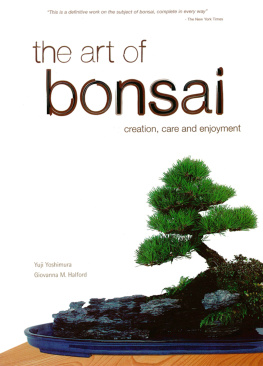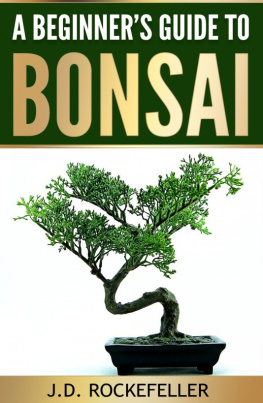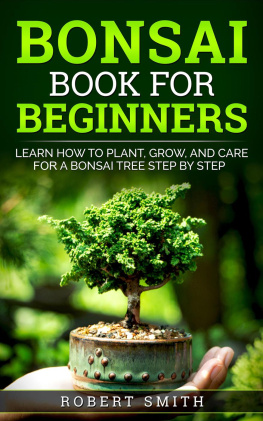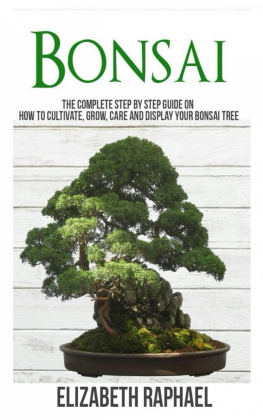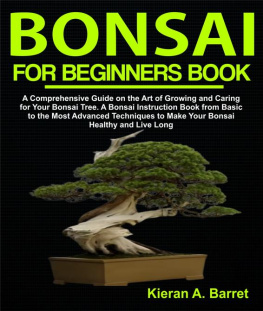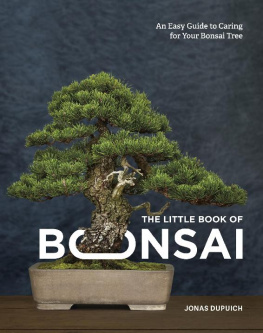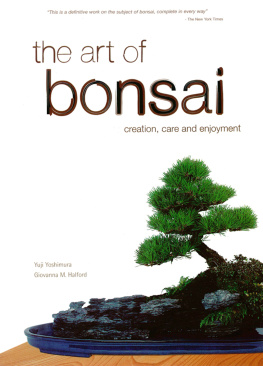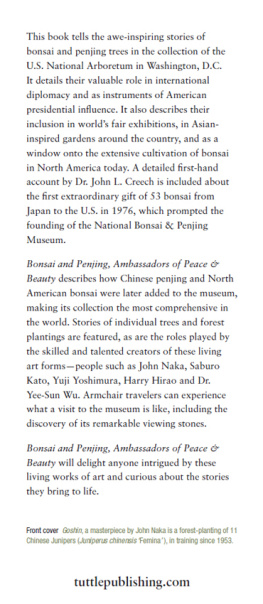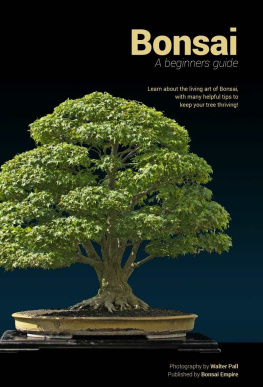Yuji Yoshimura - The Art of Bonsai: Creation, Care and Enjoyment
Here you can read online Yuji Yoshimura - The Art of Bonsai: Creation, Care and Enjoyment full text of the book (entire story) in english for free. Download pdf and epub, get meaning, cover and reviews about this ebook. year: 1996, publisher: Tuttle Publishing, genre: Children. Description of the work, (preface) as well as reviews are available. Best literature library LitArk.com created for fans of good reading and offers a wide selection of genres:
Romance novel
Science fiction
Adventure
Detective
Science
History
Home and family
Prose
Art
Politics
Computer
Non-fiction
Religion
Business
Children
Humor
Choose a favorite category and find really read worthwhile books. Enjoy immersion in the world of imagination, feel the emotions of the characters or learn something new for yourself, make an fascinating discovery.
- Book:The Art of Bonsai: Creation, Care and Enjoyment
- Author:
- Publisher:Tuttle Publishing
- Genre:
- Year:1996
- Rating:5 / 5
- Favourites:Add to favourites
- Your mark:
- 100
- 1
- 2
- 3
- 4
- 5
The Art of Bonsai: Creation, Care and Enjoyment: summary, description and annotation
We offer to read an annotation, description, summary or preface (depends on what the author of the book "The Art of Bonsai: Creation, Care and Enjoyment" wrote himself). If you haven't found the necessary information about the book — write in the comments, we will try to find it.
The Art of Bonsai: Creation, Care and Enjoyment — read online for free the complete book (whole text) full work
Below is the text of the book, divided by pages. System saving the place of the last page read, allows you to conveniently read the book "The Art of Bonsai: Creation, Care and Enjoyment" online for free, without having to search again every time where you left off. Put a bookmark, and you can go to the page where you finished reading at any time.
Font size:
Interval:
Bookmark:
APPENDIX
TOOLS AND EQUIPMENT
The various bonsai tools and equipment actually used in Japan are illustrated in Plates 237- 45. Although these exact items may not always be readily available elsewhere, satisfactory common-sense substitutes can generally be found. Nor are all these various items absolutely essential: the most common operations can be adequately performed with the eight basic tools listed on page 177.
In the following paragraphs there will be given first a description of the various tools shown in the plates, then a list of the eight basic tools, and finally a ready-reference outline of the tools required in any given operation. In each case the numbers and letters used to describe the items are the same as those superimposed upon the plates themselves.
DESCRIPTION OF TOOLS AND EQUIPMENT
Working tables. The arrangement shown has proven ideal in actual use. The height of all the tables is approximately inches, with the center table slightly higher. (a) Main table is 23 by 30 inches in area. (b) Trash box has a removable cover (7 1/2 by 22 inches) and stands open when in use. The inside is painted with a protective coating of tar and a whisk broom is hung on a hook near the top. (c) Side tables have an area of 18 by inches each. (d) Revolving stand, a most important piece of equipment, is described in more detail under item 13.
Pincettes. (a) Pointed, used for trimming juniper, cryptomeria, and. spruce. (b) Ordinary. These pincers are used for the same purposes as the foregoing and also for weeding, removing old leaves, and catching insects. The points can be used for removing hardened soil from roots when repotting, although the iron hook (7) is, in general, better for this purpose. The Hat head is convenient for a number of purposes: for the final pressing down of the soil and dry, powdered moss after re-potting, for loosening the soil from the pot before repotting, for handling moss either in powdered or living form.
Scissors, cutters, and shears. (a) For trimming leaves of all deciduous trees except flowering or fruit-bearing varieties. (b) For cutting the thinner types of wire. (c) For trimming and pruning thin branches and twigs and, when repotting, for cutting off exposed roots which cannot be pushed down into the soil. (d) The long handles make these scissors useful for trimming branches or shoots which are hard to reach. but these an' not strong enough for heavy branches or roots. (e) These scissors can be used for cutting branches up to the thickness of the thumb and are the standard scissors for flower arrangement. (f) For cutting heavy branches or roots these shears may be used, but in general it will be found that the knife Sb will make a flatter cut.
Brushes and whisks. (a) Animal-hair brush with bamboo handle, used in smoothing the top soil while repotting and in spreading sand in a group planting. (b) A smaller version of the same brush, for miniature bonsai. (c) Coconut-fiber whisk for smoothing soils while repotting, cleaning the inside of pols, and sweeping away excess soil. This particular brush has been considerably worn away by use, while an unused brush of the same variety is shown as item 4e. (d) Coconut-fiber whisk for cleaning inside of pots only, being too coarse for smoothing soil. (e) An unused version of item 4c.
Knives and razors. (a) Metal-and-ivory bud-grafting knife. The metal blade is used for cutting the bark and the ivory tip for holding the bark open while the bud is inserted. (b) Heavy-duty knife with wooden scabbard, used to cut wood and to pare away branches flat with the trunk. (c) Light-weight knife with leather scabbard, used only for cutting and grafting. The blade is very thin and sharp and must be used with great care to avoid cutting too deeply. (d) Razor with metal cover, used for grafting thin branches and particularly suitable for top-grafting of pines.
Whisk brooms. (a) Usually hangs inside the trash box (1b). (b) Heavy-duty whisk for general sweeping. This is particularly useful in sweeping under bonsai pots about once a week to avoid insects' making their nests there.
Iron hook with wooden handle Used in removing hardened soil when repotting. Must be used with caution so as not to loosen too much soil or damage the root.
. Trowels. (a) For pressing down the soil when repotting has been finished. (b) For same and for collecting moss.
. Various sizes of bamboo chopsticks used in repotting for loosening old soil and for working new soil down into the roots.
Covers for holes in bottom of pot. (a) Specially made covers of clay. (b) Potsherd. This should be about twice the size of the hole to be covered and should be placed concavely above the hole. (c) Coconut fiber. (d) A hole drilled in a vase to make it a bonsai pot, and its specially made clay cover.
Shovels. (a) Sharpened shovel and leather sheath used for digging in hard earth. (b) For transplanting plants with their soil. (c) Small copper or brass shovel for use with miniature bonsai. (d) Shovel commonly used for repotting.
String. (a) Coconut-fiber string for tying down top-heavy pots. (b) Hemp string for tying plant in the pot after finishing repotting and for tying moss and peat in rock plantings.
Revolving stand for working tables (see 1d). (a) Top, 11 1/2 inches in diameter and 1 1/4 inches thick, made of hard wood. (b) Base with drawer and casters, 12 by 12 inches square, 4l inches high.
Nest of sieves. (a) Holder into which a sieve is placed when being used. This is tall enough to accommodate all seven sieves for storing. (b) Top for holder, used both for storing and to avoid dust when sieving. (c-i) Sieves in various sizes.
Hammers, used for tapping rocks or breaking pots.
Pliers. (a-c) Used for stripping off bark when making a driftwood-style bonsai and for unbending training win' to remove it from branches. (d-f) Used for same purposes as foregoing and also for straightening the thinner gauges of used wire, for cutting wire, and for twisting wire when wiring a bonsai into its pot or making a rock planting.
. Lever, used to bend large branches.
. Jack, used to pull large branches toward trunk.
. Small anvil and wooden mallet, used to straighten heavy wire.
. Pincers. (a-b) For cutting heavy branches, trunks, roots, etc. (c) For cutting heavy wire. (d) For heavy-duty cutting of wood or wire.
. Copper wire in various sizes. (a-e) Cut into short lengths for convenience in use by beginners. (f-g) Uncut.
. Iron rods. (a) For bending heavy branches. (b) For straightening heavy trunk. (c) For straightening thinner trunk.
. Tape. (a) Friction tape, for covering exposed surfaces after cutting off heavy branches. Also, if a branch is accidentally broken while wiring, the quick application of this tape around the break may save the branch by preventing the entry of air. (b) Paper tape, for wrapping wire to be used on tender bark.
. Chisels and awls, used to make holes in rock to fix copper wires.
. Wood-carving tools, used to carve designs on trunks, to carve out stumps of branches, and to peel the bark when layering.
. Iron pick for removing scale from branches.
. Saws, for cutting heavy trunks or roots.
. Sprays of various sizes for watering can, made of copper or brass.
. Sprayers. (a) Compression sprayer with fine nozzle; can also be used for watering foliage with a mist spray. (b) Ordinary type of insect sprayer. (c) Mouth sprayer.
. Scales and measures. (a) For weighing solids. (b-e) Various sizes for measuring liquids.
. Hypodermic syringe for injecting insect holes.
. Toothbrush, for washing trunk when making driftwood styles.
. Markers of wood, plastic, and light metal.
. Watering cans of various sizes, made of copper, brass, or galvanized metal.
Font size:
Interval:
Bookmark:
Similar books «The Art of Bonsai: Creation, Care and Enjoyment»
Look at similar books to The Art of Bonsai: Creation, Care and Enjoyment. We have selected literature similar in name and meaning in the hope of providing readers with more options to find new, interesting, not yet read works.
Discussion, reviews of the book The Art of Bonsai: Creation, Care and Enjoyment and just readers' own opinions. Leave your comments, write what you think about the work, its meaning or the main characters. Specify what exactly you liked and what you didn't like, and why you think so.

